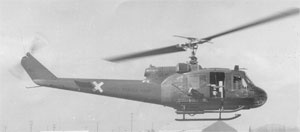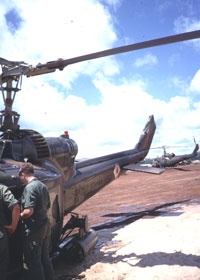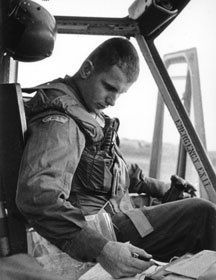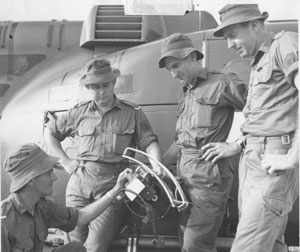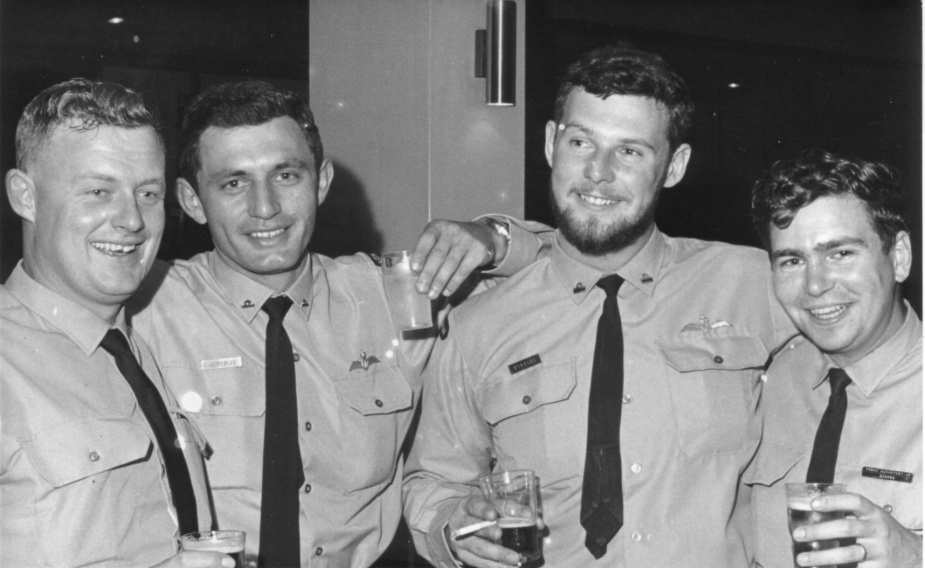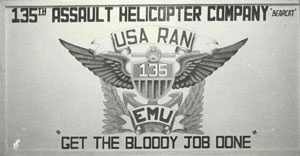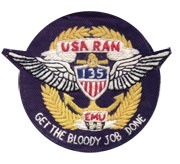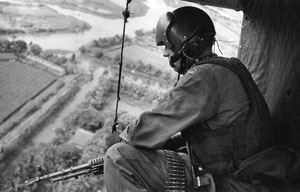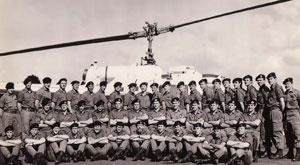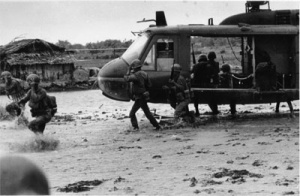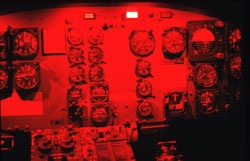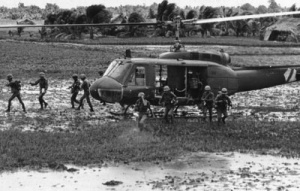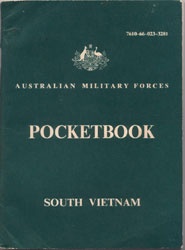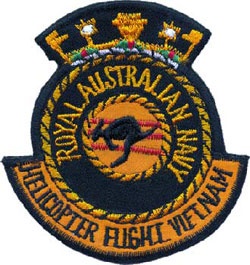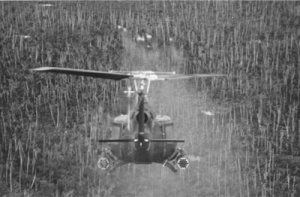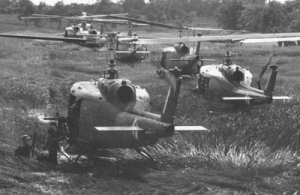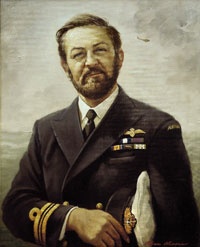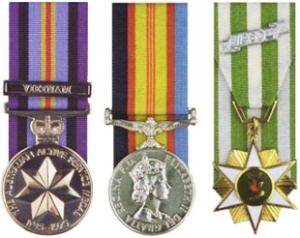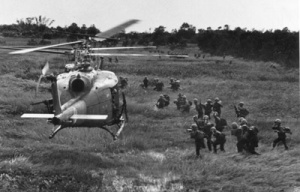RAN Helicopter Flight Vietnam History
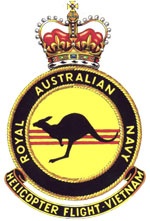
As the name suggests, the Royal Australian Navy Helicopter Flight Vietnam (RANHFV) was specially formed for service in support of allied forces during the Vietnam War.
Mr Allen Fairhall, Minister for Defence, announced the formation of this unit on 14 July 1967. The new flight was to be integrated with the United States Army 135th Assault Helicopter Company (AHC) flying the ubiquitous Iroquois helicopters in both the utility and gun-ship configurations.
The first contingent
The first contingent of pilots, observers, naval airmen and support staff was assigned to 723 Squadron Naval Air Station (NAS) Nowra in July 1967 under the command of Lieutenant Commander Neil Ralph, RAN. The flight consisted of eight pilots, four observers, four aircrewmen, 24 technical sailors and six support staff comprising of cooks, stewards, writers (clerks), medics and storemen.
Following an eight week period of training, the first contingent arrived in Vietnam on 16 October 1967 and was quickly integrated with the 330 personnel of the 135th AHC. As a result of this unique relationship between the RAN and the US Army, the unit was officially designated ‘EMU’, for Experimental Military Unit. This was fitting, given that the emu is a native Australian bird, and in some ways comical as the emu cannot fly.
135th Assault Helicopter Company
The 135th AHC was based at Vung Tau and organised to operate two troop lift (‘slick’) platoons, each with eleven UH-1Ds, a gunship platoon with eight UH-1Cs, a maintenance platoon with a single UH-1D and a headquarters platoon. Six of the gunships were equipped with mini guns, rockets and machine guns. The remaining two were fitted with the XM-5 40mm grenade launcher system (mounted in a ball turret under the nose of the helicopter) rockets and machine guns.
The role of the 135th AHC was to provide tactical air movement of combat troops, supplies and equipment in air-mobile operations. This included augmentation of army medical services, search and rescue and the provision of a command and control aircraft capability to supported units.
First operations
Having established their camp, and with a full complement, the 135th AHC become fully operational and flew its first mission on 3 November 1967. By the end of November the company had flown 3182 hours in support of the US Army 9th Infantry and the 1st Australian Task Force based at Nui Dat, Phuoc Tuy province. The usual daily commitment was one UH1H command and control helicopter, four UH1C gunships and ten slicks.
The company's first major operation, Operation SANTA FE, was a lift of 9th Infantry Division troops into northeast Phuoc Tuy in early November 1967. This operation involved more than 80 helicopters from a number of helicopter companies flying in support of a combined allied sweep against the 5th Viet Cong Division. It was also one of the largest operations any RANHFV contingent participated in. Operation TIGER CORONADO followed and it was during this operation that helicopters of the AHC were first hit by enemy fire.
First helicopter shot down
The first EMU aircraft to be shot down (and the first with an Australian pilot to be hit) was a gunship piloted by Lieutenant Anthony Casadio, RAN. This occurred on 19 November 1967, during an attack on Viet Cong positions in the Rung Sat Special Zone near Saigon. After his gunship was hit by ground fire several times, Lieutenant Casadio force-landed near the enemy. Once on the ground the Viet Cong immediately attacked the helicopter crew. Despite their relative inexperience, the young American soldiers and their Australian Navy captain maintained control of the situation and set up a defensive perimeter using the helicopter’s door mounted M60 machine guns. The M60s combined with the small arms they all carried afforded the crew a degree of self-protection. Meanwhile Lieutenant John Leek, RAN, in an accompanying gunship circled overhead until his fuel ran dangerously low and he was forced to leave the scene.
Before Lieutenant Casadio and his men were rescued by another EMU helicopter, they successfully drove off an unknown number of Viet Cong, killing two of the enemy in the process. A Chinook helicopter later lifted the downed helicopter from the crash site and recovered it back to Vung Tau.
Camp Blackhorse
In December 1967 the company experienced its first night combat operations and Lieutenant Commander Ralph experienced his first assignment as air mission commander. In late December the company moved from the secure base at Vung Tau to Camp Blackhorse, thirty five miles away and on a main road five miles south of Xuan Loc, Long Khanh province. Blackhorse, in the middle of rubber plantations and jungle, was dependent on convoys from Long Binh to bring food, ammunition and fuel to it. It was also dangerously vulnerable to rocket and mortar attack. Its unsealed runways caused it to be extremely dusty in the ‘dry’ and, conversely, a sea of mud in the ‘wet’ so that take offs and landings required more than the usual exercise of caution.
The shift to Blackhorse committed the 135th to the support of more units over a greater area. On 8 January 1968, eight EMU helicopters were hit by enemy ground fire while supporting elements of the 9th Infantry Division's 3/39th Infantry Battalion outside Saigon. On this occasion the insertion and extraction of troops that went on well into the night was led by Lieutenant BC Crawford, RAN.
First RAN sailors injured
On 12 January 1968 the RANHFV suffered its first casualties when Leading Seaman Kevin French and Naval Airman Keith Wardle of the maintenance platoon were injured when the gunship in which they were travelling was forced down in jungle some miles north of Baria, Phuoc Tuy province. The men scrambled clear as the wreck caught fire, detonating ammunition and rockets. A RAAF helicopter from 9 Squadron was soon on the scene and the downed aviators were winched from the jungle and evacuated to hospital. Leading Seaman French soon recovered from this ordeal but Able Seaman Wardle suffered very severe injuries, necessitating his evacuation to Australia.
The 135th’s relationship with 9 Squadron, RAAF, was first established when both units shared the tarmac at Vung Tau, this relationship was further strengthened early in 1968 when 9 Squadron began to replace its UH-1Bs with larger and more powerful UH-1Hs. To help the RAAF Squadron achieve an easy transition it was arranged that a number of its pilots would be attached to the 135th’s slick platoons for conversion training. Subsequently, RAAF and RNZAF pilots saw action with the EMUs for several months. It should be noted that RAN pilots also augmented the Royal Australian Air Force’s (RAAF) No. 9 Squadron RAAF in Vung Tau through the RAN Detachment, 9 Squadron Vietnam.
Operations continued throughout January 1968 during which Lieutenant Commander Ralph and the crew of the command and control helicopter survived three mortar attacks on the ground during a vigorous fire fight between a Viet Cong force and elements of the US 25th Infantry Division at Duc Hoa west of Saigon. Two company gunships were hit by enemy fire and during the widespread Tet Offensive of February 1968, the increasing Viet Cong activity in III Corps emphasised the vulnerability of Blackhorse. Skirmishes on the boundaries became frequent and the enemy mining of the road from Long Binh to Baria, via Xuan Loc disrupted supply convoys causing shortages of spare parts.
First EMU personnel killed in action
On 8 February members of an enemy group, later assessed as five companies strong, attacked EMU aircraft flying in support of the 9th Infantry Division near My Tho. In this action, sniper fire was directed at the ten lift aircraft led by Lieutenant Commander Pat Vickers. On the third lift in, automatic fire and Rocket Propelled Grenades (RPG) brought down one helicopter that crashed into the jungle. All the US Army crew were killed. Sub Lieutentant Jeff Dalgleish had a lucky escape in this action when rounds pierced the tail boom of his aircraft and almost severed the tail rotor control cables. He landed the helicopter just as the cables gave way and until he could be lifted out he was protected from further attacks by covering gunships. Forced down nearby was a helicopter piloted by Lieutentant Crawford that had been hit in the fuel tank. Most of the crew from the two downed aircraft spent the night with 9th Infantry Division troops before being airlifted back to Blackhorse. During the action eight helicopters were hit by ground fire and two were irreparably damaged.
On 20 February, EMU helicopters assisted the 1st Australian Task Force in Operation CLAYTON, a cordon and search of the village of long Dien near Dat Do on Highway 23 in Phuoc Tut province. Two days later Lieutentant Commander Vickers was fatally wounded while piloting the lead aircraft in a mission to lift out troops of the 18th Army of the Republic of Vietnam (ARVN) Division near Xuan Loc. Descending to the pick up zone, his aircraft was hit by enemy fire and Lieutentant Commander Vickers was wounded. The co-pilot immediately flew the helicopter to Blackhorse, landing on the hospital pad within five minutes. Notwithstanding this prompt action Lieutentant Commander Vickers died without regaining consciousness.
Enemy activity at Blackhorse
With the Tet Offensive declining, enemy activity decreased around Blackhorse. This, however, did not stop the base from being the target of 42 enemy mortar rounds in the early hours of 9 March. Not all of the missiles exploded, however eight personnel were injured and several buildings sustained minor damage. Enemy mining of Blackhorse-Xuan Loc road continued and Petty Officer OC Phillips, the company’s construction NCO, escaped injury when a vehicle he was travelling in detonated a mine tearing off one the vehicles tracks. An American civilian engineer was killed in this incident.
Operation ASHGROVE TRAM
On 25 March 1968, EMU slicks with helicopters of 9 Squadron RAAF lifted troops of ANZAC Battalion (2nd Battalion RAR/1st Battalion RNZIR) from Nui Dat to Xa Long Hai, a fishing village at the foot of the Long Hai Hills. A total of 2085 Vietnamese were screened in this operation, code named ASHGROVE TRAM. The infantry were lifted back to Nui Dat the next day.
By the end of March 1968, the EMUs were flying in support of the 5th, 18th and 25th ARVN Divisions. The commitment to combat assaults and troop lifts was varied by general support missions carried out every fourth day. The company also supplied eleven utility helicopters which were employed singly as command and control aircraft for ground operations, and for essential administrative and resupply sorties.
Ambushes
Early in May, an 18th ARVN Division convoy was ambushed on highway 1 at Dinh Quanh north of Xuan Loc. The rapid counter action of the ‘Taipans’ (the EMU gunships) and tactical air support helped to kill 200 of the attacking Viet Cong.
On 18 May a flight of ten Hueys put down in a landing zone near Tan An without the usual ‘softening up’ by artillery and gunships in an attempt to take the Viet Cong by surprise. The experiment proved disastrous. The helicopters settled into the paddy field without opposition but, as their troops began to disembark, they came under intense fire from the Viet Cong who had been waiting, concealed in small ‘spider’ holes, complete with lids which had rice growing on them. All the aircraft were hit and some of the ARVN troops panicked and refused to get out. After unloading their troops all of the helicopters took off but few made it back to base as most crashed or force landed on the way. Two helicopters were 'written off' and the remaining eight were badly damaged. Though aircraft were seriously damaged, crew injuries generally were light. One crew remained unscathed in spite of 22 rounds passing through the aircraft while a bullet passed through the windscreen of Lieutenant Crawford’s helicopter, three inches from his head. As this ambush had successfully immobilised most aircraft of this EMU flight, a relief flight was called in to complete the operation.
Jungle crash
On 13 June Lieutenant John Leak, Lieutenant Andy Craig (of RAN detachment, 9 Squadron RAAF), and Leading Air Mechanic A Green were injured when a lateral cyclic control rod broke (possibly due to gunfire), sending their helicopter into an uncontrolled spiral dive. It came out of the dive just above the jungle canopy, but still out of control it crashed through the trees coming to rest in a more or less level position. The injured crew extracted themselves from the wreck with the engine of the aircraft screaming and unable to be shut down. After spending some time alone in enemy occupied territory they were later winched to safety by a RAAF MEDEVAC (medical evacuation) helicopter and taken to the 1st Australian Field Hospital at Vung Tau, later being evacuated to Australia.
Aircraft hit
Six company aircraft were hit on 25 July while bringing troops of the 25th ARVN Division into a landing zone near Ben Luc, southwest of Saigon. Light enemy fire received on the first landing was suppressed by the accompanying gunships. The six aircraft were hit on the second landing by rifle fire from Viet Cong who were well entrenched in ‘spider’ holes with concrete lids. Six disembarking ARVN soldiers were killed during this insertion. On this occasion the helicopter piloted by Lieutenant Godfrey received several rounds, but no RAN personnel were injured.
August 1968 brought large scale enemy movements through III Corps, in contrast to June and July, when contact with Viet Cong was infrequent. Blackhorse again attracted attention in the form of mortar attacks in the early hours of 15 August, and it became apparent that this was a Viet Cong tactic to keep helicopter gunships grounded while they attacked ARVN outposts at Gia Ray ten miles from the camp. Heavy fighting followed nearer Blackhorse on the 23rd as units of the 18th ARVN Division battled with a large Viet Cong force. The EMUs kept the ARVN units supplied with reinforcements and lifted an ARVN battalion into a blocking position to the rear of the enemy.
Further casualties
The gunship platoon suffered further casualties on 21 August 1968 when a light fire team was engaged by enemy troops equipped with Rocket Propelled Grenades (RPGs) near Blackhorse. The lead gunship, captained by Lieutenant Casadio, RAN, flying at treetop level was hit by one of these deadly projectiles and exploded in flames before crashing through trees and exploding. Lieutenant Dalgleish, RAN, landed his helicopter quickly in an attempt to rescue the crew, but all had been killed, and the exploding ammunition stopped attempts to extinguish the fire. Petty Officer OC ‘Darky’ Phillips of the RANHFV also lost his life in this incident as did Warrant Officer Hershel Bullock (USA) and Specialist 4 William Fennell (USA). The loss of these aviators was deeply felt within the 135th AHC.
The second contingent
The 2nd Contingent of the RANHFV led by Lieutenant Commander Graham Rohrsheim, RAN arrived at Blackhorse on 9 September 1968. In order not to leave the 135th depleted of experienced personnel at one time the sailors of the 1st Contingent departed in two groups. Lieutenant Commander Rohrsheim subsequently relieved Lieutenant Commander Ralph taking over duties as the Executive Officer of 135th Assault Helicopter Company.
Enemy activity in III Corps during this period was most distinct in Tay Ninh province northwest of Saigon. The company continued to fly in support of the 5th and 25th ARVN Divisions, the ARVN Airborne Brigade, elements of the US 9th and 25th Infantry Divisions and the 1st Australian Task Force. Contact with the enemy remained light until 23 October, when 9th Infantry Division units met heavy resistance southeast of Ben Tre, Kien Hoa province. The EMUs led by Lieutenant Commander Rohrsheim made seven landings in three landing zones resulting in two aircraft being shot down and seven damaged with four crewmembers being injured. Lieutenant Tom Supple, RAN, helicopter was one of those brought down but a second machine, captained by Sub Lieutenant Anthony Huelin, RAN braved intense ground fire and rescued the downed aviators.
Move to Bearcat
The newly arrived Australians had hardly settled into their new surroundings when, in November, the 135th was redeployed to the Thai Army's Camp Bearcat 32 kilometres north east of Saigon in Bien Hoa province. This change of parent battalion occurred frequently during the four year RANHFV/135th AHC integration, a disruptive event as the battalion HQ was responsible not only for the control of company personnel, but also for the provision of building materials and recreational facilities. The move to Bearcat added support for Thai Forces to the operational commitments of the EMUs, as at that time the camp was the main base of the Royal Thai Army in Vietnam. As with Blackhorse, Bearcat was also subject to attacks from mortar attacks and frequent perimeter incursions from the enemy.
January 1969
1969 commenced badly for the 135th when, on 3 January, a helicopter captained by Sub Lieutenant Anthony Huelin, RAN crashed after striking power lines near Saigon. The mission involved flying from Bearcat to the Seven Mountains area, Chau Doc Province, a distance of about 140 miles. Low cloud and fog conditions were prevailing at the time, but because of the importance of the mission Sub Lieutenant Huelin was unwilling to abandon it. He took off on the long flight early in the morning and, remaining dogged by thick cloud, hit the power lines just before dawn. Those killed in this tragedy included Sub Lieutenant Huelin, RAN, Warrant Officer William Childers (USA), Specialist 4 Ernest Dodson (USA), and Specialist 4 Larry McPherson (USA).
Operations in IV Corps
The dry season campaign of the 7th and 9th ARVN Divisions in IV Corps had begun on 8 December 1968. The 135th was under the control of the 214th Aviation Battalion for these successful field operations in which 89 Viet Cong had been killed by the end of the year.
This new commitment to operations in IV Corps necessitated long flying hours as the 7th and 9th ARVN Divisions were in action in the Delta from My Tho, a provincial city 35 miles south of Saigon, across to Long Xuyen, nearly 100 miles from Saigon. The campaign to clear the northern IV Corps provinces of enemy forces continued through January and February 1969 with the EMUs engaged almost entirely in the provinces of Sa Dec, Vinh Long and Vinh Binh, assisting the 9th ARVN Division.
Contact at Vinh Long
During the early evening of 2 February 1969 the EMUs took part in a vigorous action in Vinh Long province. The slicks were held down in the landing zone by heavy fire from a Viet Cong force entrenched in a tree line. Some of the gunships called in to assist in extricating the slicks were themselves hit and forced down and among these was the helicopter of Lieutenant Tom Supple, RAN. Once on the ground, enemy soldiers attacked the crew, which included Sub Lieutenant WE Symons, RAN. Armed with the downed Huey’s M60 machine gun and small arms, the aviators were involved in a running gunfight with the enemy as they were chased across the paddy fields under heavy fire. Another Huey crewed by Australians Sub Lieutenant Mick Perrot, RAN and Sub Lieutenant RJ Kyle, RAN, seeing what was taking place maneuvered their aircraft through intense ground fire to reach and rescue the downed aircrew. Later that month Sub Lieutenant Symons was wounded in action during night operations on 22 February and following surgery at the 1st Australian Field Hospital returned to Australia in March. Lieutenant Andy Craig, RAN, from 9 Squadron RAAF replaced him in the contingent.
In 2979 flying hours during February 1969, EMU aircraft received 48 hits, and the company killed 52 Viet Cong.
“Get the Bloody Job Done“
The February 1969 RANHFV Report of Proceedings contained the first reference to the unique unofficial badges worn by the men of the 135th AHC. It stated:
In an endeavour to boost the morale and unity of the Company, the Commanding Officer offered $25 and a 3-day pass to Vungtau for the designer of a new Company Crest and NAMAE Hughes’ entry won the competition. It is a very impressive combination of an anchor and US Army wings in a laurel wreath with USA-RAN inscribed in a scroll above the motto; GET THE B... JOB DONE written below.
A further reference was made to the badge in the 16 May 1969 RAN Navy News which ran a story on the emergence of this unique badge that has become synonymous with the unit and remains so to this day.
Eagle flights
As the dry season campaign progressed in March and April 1969, the enemy scored fewer hits on EMU aircraft while continuing to suffer high losses themselves; by early April the 135th’s aggressive airmobile tactics had broken enemy regiments and battalions into companies or smaller units
As Viet Cong units became smaller, ‘Eagle flight’ tactics were widely used. A single gunship, or small flight, directed by the ground commander who took advantage of freshly acquired intelligence, quickly searched an area for caches and enemy locations. On 18 April, and EMU aircraft on one of the missions engaged a Viet Cong company, preventing its escape while troops of the 7th ARVN Division closed in to capture twenty five of the enemy. Sub Lieutenant JMW Hart, RAN, was the co-pilot of this gunship that killed ten of the enemy in the exchange of fire.
In mid-May, Viet Cong mortar attacks on Bearcat increased in frequency causing EMU aircraft to be evacuated to Blackhorse on a number of occasions. This necessary but inconvenient move required the helicopter crews to be pre-briefed at Bearcat for the next day’s mission after a full day’s flying, given an issue of field rations and sent to Blackhorse to sleep on stretchers or in their aircraft until their departure for operations at 05:00.
May-July 1969
On 31 May the Taipans (gunship platoon) suffered a serious loss while trying to suppress the fire of enemy troops during an assault landing near Dong Tam. Captain Dennis Phillips' (USA) gunship crew located enemy troops and swung out of formation to engage them. The Huey’s gunners, Leading Seaman Noel Shipp, RAN, and Specialist 4 Byron Bowden (USA) hung outside the cabin exposed to intense fire as they engaged the enemy with their M60 machine guns. In the course of this action the helicopter was struck by ground fire and Captain Phillips was seriously wounded. The stricken gunship spun down out of control, striking the ground and exploding before the co-pilot, Warrant Officer Steven Martin (USA), could regain control. All of the crew was killed instantly. Leading Seaman Shipp was seen to continue firing his weapon at the enemy until the moment of impact.
The 135th suffered further losses while attempting to evacuate a large number of ARVN wounded near Cae Be on 16 June. Braving intensive fire, three helicopters were downed and Able Seaman CC ‘Blue’ St Clair, RAN, a door gunner, was seriously wounded and subsequently evacuated to Australia.
Operations in July concentrated on the closing of enemy supply routes from Cambodia into northern IV Corps. The major action involving RAN personnel in July was a dusk encounter with an enemy unit. Sub Lieutenants Symons and Supple in two light fire teams killed sixteen Viet Cong, and ARVN soldiers captured another eight. Three remaining Viet Cong surrendered to an ARVN outpost the next morning. Eleven EMU aircraft were damaged by enemy fire during the month with four US army aircrew being killed.
The third contingent
The first personnel of the third RANHFV contingent arrived in Vietnam on 10 September 1969 under the command of Lieutenant Commander DD Farthing, RAN, who relieved Lieutenant Commander Rohrsheim on the 16th. An observer, Lieutenant PJ Arthur, who later became company operations officer, was second-in-command while Lieutenant R Giffen was the senior pilot. The second component of the contingent arrived on 8 October.
3rd Contingent RAN Helicopter Flight Vietnam
The typical combat group provided by the EMUs at this time consisted of one UH1H command and control helicopter, three UH1C gunships, and eight UH1H slicks. Two further slicks were provided as direct combat support aircraft (‘swing ships’) that operated independently on reconnaissance and courier missions and which could give general support to ARVN regimental commanders.
On 23 September 1969, a Viet Cong was wounded and captured in Sa Dec province by the crew of a gunship piloted by Lieutenant Giffen and Sub Lieutenant Symons. The following day members of RANHFV '69 came under fire for the first time when seven slicks were hit in a combat assault in Kien Hoa province. Though many rounds pierced the helicopter cabin areas, the aircrews and embarked ARVN troops remained unscathed.
In October, enemy activity in IV Corps was generally moderate, but increased infiltration of men and material through the Plain of Reeds in preparation for the winter-spring campaign was observed.
Sub Lieutenant C Mayo was the co-pilot of one of three helicopters hit by enemy fire near the town of Go Cong in the province of the same name on October 30, and forced to make emergency landings. Two US Army crewmen were injured.
Winter-spring campaign
The Viet Cong began the winter-spring campaign in IV Corps with widespread attacks during the night of 6 November 1969. The influx of North Vietnamese Army (NVA) replacements into the major enemy units improved their combat effectiveness especially in Dinh Tuong province. Here, in a supposedly pacified area, EMU gunships were sent to the aid of a battalion of the 7th ARVN Division on 18 November. In spite of substantial air support, two Viet Cong battalions armed with rockets and 50-calibre machine guns overran the battalion. Fifty five ARVN soldiers were killed with their two US Army advisers, and two EMU helicopters were seriously damaged. Sub Lieutenant R Marum was left 'startled, but unhurt' when a round pierced the windscreen of his slick and ricocheted off his flying helmet. Later as a platoon leader, Marum was wounded again near Cai Be on 22 January 1970. In this incident his helicopter was repeatedly hit by enemy gunfire with a round ripping through his left leg, then his left hand before continuing its upward flight and striking him in the chest after deflecting off his ‘chicken plate’. The co-pilot managed to fly the damaged Huey to a nearby fire support base from where his wounded captain was evacuated to hospital. Lieutenant Marum later returned to the 135th but his ongoing tour of duty remained full of incident with the helicopter piloted by him being hit on no less than 11 separate occasions.
Problems with the supply of replacement aircrew, an increasing number of battle damaged helicopters, and rigid enforcement of the 140 hour per month limit of pilot flying hours, all combined to force a reduction in the EMU aircraft flying time from nine hours per day to six.
The total aircraft flying hours for November were 2547, some 400 less than October’s total of 2949. Although total flying hours for November were lower, there was only a slight reduction of individual flying hours as many US army pilots were not being replaced on completion of their tour of duty.
Phase II of the winter-spring campaign began in the delta on the night of December 2 and large NVA losses occurred in Kien Tuong province in the following week. The EMUs were involved in only one major action during the month. On 19 December they went to the assistance of a Regional Force Company at Ninh Dai near the mouth of the Song My Tho (a northern branch of the Mekong ) in Kien Hoa province. A large Viet Cong force had ambushed the company inflicting heavy losses. Continuous air strikes were directed onto the enemy positions, while slicks landed an ARVN battalion to block the Viet Cong line of retreat. The action continued throughout the day with more than fifty of the enemy being killed.
The Taipans (gunships) did not have it all their own way, however, as on 1 December a gunship was repeatedly hit by gunfire with one enemy round tearing though the left leg of Sub Lieutenant Bob Giffen, RAN. The naval aviator was so seriously wounded from this and other shrapnel wounds that he was evacuated back to Australia. Despite the extent of Giffen's wounds, following his recovery he harassed naval authorities in Australia into letting him return to the RANHFV where he served out the remainder of the 3rd Contingents tour of duty
Another RANHFV member, Leading Air Mechanic E Shelley, was wounded on 23 December. He was hit in the neck when the supply truck he was driving received rifle and mortar fire on the road from Vung Tau to Bearcat. Shelley was taken to the 1st Australian Field Hospital, Vung Tau and returned to duty on 26 January 1970.
Night hunter-killer operations
Night hunter-killer tactics were introduced in January 1970 against enemy units moving along infiltration routes from Cambodia. This tactical concept required a command and control helicopter fitted with a powerful searchlight to fly at a low level and pinpoint potential targets which were then illuminated by a higher flying UH1H ‘flare-ship’. Behind the command and control aircraft flew two gunships ready to engage any Viet Cong units thus located. The dangers of this tactic were highlighted on one occasion when the lead gunship flew into a tree, wrecking the first three feet of its cabin but managing to return to Vinh Long in spite of branches embedded in the fuselage.
Changes in command of the 7th ARVN Division in January led to more aggressive field operations in Kinh Tuong, Kien Hoa and go Cong provinces. With 7th ARVN units remaining in the field for longer periods, the EMUs were required to fly a greater number of resupply missions, as well as spending many hours standing by at various points in the Delta as a reaction force.
A regional Force company was inserted into an area some miles east of Giong Trom, Kien Hoa province, early on 25 January 1970 and was ambushed that afternoon by a Viet Cong company. EMU gunships and US Navy Bronco aircraft killed 43 of the enemy while the Regional Force company suffered only four casualties.
Enemy activity in the delta increased markedly in late February with the 88th NVA Regiment attempting to infiltrate southwards from the Plain of Reeds. At this time, the 135th was hampered in carrying out its allocated missions by a shortage of aircraft and aircrew. On occasions, aircrew had to be seconded from other companies to enable the operational commitments of the EMUs to be met.
In February, EMU operations centered on Mo Cay in western Kien Hoa province. Here, on the 17th, Lieutenant Marum’s Huey was again hit by enemy fire and a crewmember, Specialist 4 MA Jenewein, USA, was fatally wounded. Later in the month, EMU gunships killed 27 Viet Cong in the same area.
Lieutenant DB Gibson injured
Lieutenant Dave Gibson was seriously injured on 6 March when he brought his slick into a landing zone east of Ben Tre that had been booby trapped with a 105mm artillery shell. The shell detonated as the helicopter was hovering above the landing zone with the explosion completely destroying the helicopter and killing two ARVN soldiers travelling in it. Seriously wounded, Lieutenant Gibson was evacuated to Australia and did not return to the RANHFV. On the same day a gunner in Sub Lieutenant Clive Mayo’s gunship was badly wounded in an action in which about 30 enemy troops were killed.
Five EMU slicks were again hit by enemy fire on 25 March while landing troops of the 10th Regiment, 7th ARVN Division, two miles east of Mo Cay. Sub Lieutenant EK Wile's crew were lucky to escape becoming casualties during this operation when they were forced down after receiving enemy fire. Once on the ground the enemy attacked the aviators and they found themselves involved in a 30 minute firefight during which they accounted for two of the enemy. They were subsequently pulled out by another helicopter and evacuated to safety.
Serious deterioration in the manning of the 135th, especially shortages of key maintenance personnel and senior enlisted men in the helicopters (crew chiefs) affected the availability of aircraft and reduced the total hours flown in April to 2401, the lowest figure for twelve months. The manning improved in May when enlisted men were up to 100 percent of complement, but pilots remained 20 percent below strength.
During a combat assault in Kien Hoa province on 28 April, a helicopter commanded by Sub Lieutenant Mayo was hit by heavy enemy fire and the US Army crew chief wounded in the legs. Thirty Viet Cong were killed in this action.
Cambodian operations
The Joint United States/South Vietnamese drive across the Cambodian border to destroy enemy base areas began on 5 May 1970.
EMU helicopters took part in the first phase of these operations, but without RAN personnel, as an important provision of the Australian/United States Working Agreement was that Australian servicemen would not take part in operations near the Cambodian border. As all of the lead pilots and all but one of the command and control pilots at this time were RAN, the enforced absence of the Australians hampered the efficiency of the 135th. It was subsequently soon reassigned to supporting operations in the Delta, leaving other Delta-based companies to operate in Cambodia.
Return to Binh Dai
Shortly after the Allies had declared a 24-hour Buddha’s birthday truce on 18 May, the EMUs took part in an intensive action in Kien Hoa province. A regional force outpost in the Binh Dai district had been overrun and then heavily fortified by a Viet Cong battalion. Three battalions of the 10th Regiment, 7th ARVN Division were inserted around the outpost by slicks of the EMUs and the Dutchmasters (B Troop, 7th Squadron, US Army 1st Cavalry, based at Vinh Long). The combined flight with Lieutenant Commander David Farthing as mission commander, received heavy fire from small arms and machine guns throughout the six-hour long operation. The lead helicopter, piloted again by the unfortunate Lieutenant Marum, received multiple hits and was forced to break off and return to Bearcat. Sub Lieutenant Andy Perry, RAN, who was airborne on another mission then, volunteered to lead the assault landings.
Leading the assault Perry’s Huey was badly damaged during the first insertion but made flyable in the landing zone under heavy fire. Sub Lieutenant Perry then took off and led two more lifts of troops into the bitterly contested landing zone taking further enemy fire that came through the helicopter’s windshield. A piece of shrapnel came off the pedals of the aircraft and hit Perry on the foot. Fortunately his injuries were superficial and later that night he took part in three more landings despite the fact that his cockpit lights and instruments were no longer functioning. The brand new helicopter, which Sub Lieutenant Perry was flying on this day, was so badly damaged that it never flew again.
The 21-year old Sub Lieutenant was later awarded the United States ‘Silver Star’ for his part in the action.
On 19 May further action took place when a well-entrenched Viet Cong unit hit two EMU gunships with 50-calibre machine gun fire three miles east of Cai Be. One aircraft crashed, killing all the US Army crew, The other, flown by Sub Lieutenant RJ Cooper, was able to fly to fire base Schroeder. It was later written off.
June-July 1970
Forty seven soldiers of the 88th NVA Regiment that was active in Kien Phong and Dinh Tuong provinces were killed in a major engagement with units of the 7th ARVN near My Thien, Dinh Tuong on 7 June. A platoon leader, Lieutenant Peter Clark, RAN, the air mission commander on this occasion rescued the pilot of a US Navy OV10 Bronco aircraft shot down in action. Lieutenant Clark was again the air mission commander for a major action on the 20th when he commanded aircraft from several helicopter companies in a daylong engagement near Ben Tre, Kien Hoa province, in which 76 Viet Cong were killed.
On 16 June, a flight of slicks led by Sub Lieutenant Mayo was making routine troop insertions near Giong Trom when, after three uneventful landings Viet Cong emerged from a hut and fired at the helicopters at close range. Although four aircraft were hit, only one pilot was wounded. Artillery fire, air strikes and gunship strikes killed five of the enemy.
Twenty-four EMU aircraft were hit during June, the highest number damaged since September 1969. With the Cambodian operations still in progress the 135th was required to provide most of the troop carrying helicopters for the Delta, but this requirement lessened in July as the operations phased out, so that in that month the EMUs flew their lowest number of hours for the preceding twelve months. There were only two major actions, as the loss of safe havens and supply bases in Cambodia had significantly diminished enemy capabilities in the Delta. On 2 July, Lieutenant Marum was the air mission commander in an exceptionally hazardous lift out of a battalion of the 10th Regiment 7th ARVN Division. The flight of slicks was mortared during each of the six landings that were necessary to lift out the men of the battalion with their dead and wounded.
While reconnoitering an area east of Giong Trom for a troop insertion on 13 July, Lieutenant Marum observed a number of Viet Cong in the open and called in assistance from the EMU gunships which, led by Sub Lieutenant Cooper, effectively responded to the call. Two day later Sub Lieutenant Cooper was again in action flying in support of the 335th Assault Helicopter Company. Shortly afterwards he was forced to make an emergency landing under fire near Tra Vinh, and while still under attack he and his crew were rescued by another gunship of the 335th.
During August, those NVA and Viet Cong units active in the Delta remained deployed in the same areas as in previous months. The first week of August was marked by a substantial increase in attacks, especially in Kien Giang and Chuong Tien provinces. Kien Hoa province remained at the centre of enemy activity in the EMU area of operations and little changed throughout September.
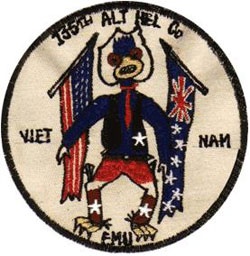
The highlight of EMU operations in August was a raid early in the month on a suspected Viet Cong hamlet in coastal Kien Hoa. A fifteen man SEAL team was transported to the hamlet in two slicks accompanied by a command and control aircraft and two gunships. As the helicopters swept in at low level from seaward, the Viet Cong, taken completely by surprise, scattered in confusion. The fire of the gunships killed twelve, while the SEALs, spending an hour in the hamlet, killed several more and took nine prisoners. The SEALS were again supported on the 25th when a Viet Cong grenade factory in Kien Hoa was located and its large stock of ‘home-made’ grenades destroyed.
Support personnel
Although they were permitted to fly on operations, the main role of the Australian (and American) clerks, cooks, medical and stores personnel was to provide vital if unspectacular support to the 135th. In the case of the cooks, this support was particularly difficult to provide. Fresh food was always a rarity and many foodstuffs were either tinned or dehydrated. The situation, however, was not all bad. The Australian cooks tried to visit Vung Tau whenever the troop transport HMAS Sydney (III) or other Australian supply ships were in port. Making the dangerous journey by road, or sometimes by helicopter, the sailors were able to ‘scavenge’ surplus rations from Sydney, which were shared among the 135th’s personnel. Through these means fresh meat, vegetables and fruit graced the 135th’s tables more often than would have ordinarily been the case. The Australians also made sure that they did not miss an opportunity while in Vung Tau to pick up as large a stock as possible of Australian beer and cigarettes from the 1st Australian Logistic Support Group.
Dong Tam
After many delays and false starts, the 135th moved from Bearcat to Dong Tam on 6 September. Operations in IV Corps had required the EMUs to make an hour-long flight from Bearcat, stopping at Dom Tam to refuel.
This long flight was acceptable when the company was making only occasional forays into the southern corps, but as the EMUs had been engaged almost entirely in IV Corps operations since December 1968, a shift to a base nearer their field of action was well overdue.
Dom Tam, in Dinh Tuong province about five miles west of My Tho and on the intersection of the Song My Tho and a large canal (the Kinh Xang), was an established US Navy and VNN river patrol base, and until a year before had held the US 9th Infantry Division.
There were still army units housed at the rear of the naval base, where the EMUs were to be quartered. Toilet and kitchen facilities were disappointingly poor, while the limited water supply allowed no provision for showers. To remedy these deficiencies, 'Operation Outhouse’, under the supervision of the company construction officer Lieutenant WM Kimpton, brought to Dong Tam the plumbing and porcelain ware of the shower and toilet block built at Bearcat. This was supplemented by a further two ten ton truckloads of plumbing ware and building materials 'acquired' with typical Australian ingenuity by Sub Lieutenant Perry. Additional ovens for the 135th’s kitchen were also brought from Bearcat.
Further difficulties arose due to the poor communications facilities at the new base. There were no telephones to link the company living quarters with the operations room a mile away.
The fourth contingent
The first group of RANHFV ’70, the last contingent, arrived ‘in country’ on 10 September 1970, and the second group on 8 October. Lieutenant Commander WP James relieved Lieutenant Commander Farthing at Dong Tam on 17 September. Lieutenant J Buchanan was the senior pilot and second-in-charge of the RANHFV.
Soon after RANHFV '70 relieved RANHFV ’69, the extent of EMU operations in Military Region 4 broadened. While the company continued to support the 7th ARVN Division in Kien Hoa Province, it began to fly increasingly for the 21st ARVN Division based at Vi Thanh in Chuong Tien province. It also began flying in support of the 9th ARVN Division based at Sa Dec some forty miles west of Dong Tam. Operations with the 21st ARVN in particular, imposed long flying hours to and from Dong Tam.
The heavy rains of the summer monsoon and the flooded Delta kept enemy activity low in Military Region 4 in October and interfered with the EMUs flying, but did not stop enemy mortar attacks.
The Dong Tam base was the target of several mortar attacks during October and November with most rounds being directed at the US Navy compound about one mile south of the 135th headquarters. On 27 October, five 85mm rounds landed close to the EMU officer’s quarters showering the building with dirt, while five EMU personnel were injured on 3 November when several 82mm rounds exploded near the company’s accommodation blocks.
Kien Long
The first major action for RANHFV ’70 occurred on 11 October near Kien Long, on the eastern fringe of the U Minh about 50 miles south west of Can Tho, where an enemy force thought to be a battalion with a heavy weapons company was entrenched in a treeline. EMU aircraft landed four times under heavy mortar and B40 rocket fire to insert ARVN troops. Five of the helicopters were hit and one, with Lieutenant BG Abraham as co-pilot, was forced down nearby. The enemy withdrew to the U Minh as night fell, leaving 26 dead in the field. The ARVN troops suffered 88 casualties.
Near the end of the month, the direct combat support helicopter assigned to Dinh Tuong was badly damaged while parked on a road when a small boy threw a rocket canister into its tail rotor.
Dinh Tuong province remained the major area of enemy activity in Military Region 4 during November. The Viet Cong continued with the pattern of night attacks which they had established three months earlier by harassing small outposts on moonlit nights to probe their defences in preparation for later attacks during moonless nights.
On 5 November the EMU gunship platoon killed three Viet Cong in the Ca Mau peninsula, and the following day, near Mo Cay, Kien Hoa province, two Viet Cong were killed by the crew of the command and control helicopter and one by the Taipans.
Early in the morning of 22 November, armed Viet Cong were detected attempting to land from a junk onto a beach in Kien Hoa province. The EMUs took ARVN troops to the area and the command and control aircraft killed one Viet Cong. The main target of Viet Cong attacks in December was the South Vietnamese pacification program, by which the government sought to extend education, health and social welfare schemes to the rural population.
December 1970
Outposts continued to be the targets of Viet Cong harassing attacks. In the early hours of 3 December, the gunships were sent to the assistance of the Lau Ba Regional Force outpost near Tra Vinh, Vinh Binh province. Lieutenant Commander James, the air mission commander, arrived just as the outpost was overrun by an enemy force and blown up. Eleven of the Regional Force defenders were killed as well as ten civilians.
The following day there was an extraordinary act of flying skill by Lieutenant Buchanan, RAN, and his crew for which the Australian pilot was awarded the Distinguished Flying Cross. While engaged in the medical evacuation of a wounded crew member from a South Vietnamese patrol boat, the group came under heavy enemy fire. Another patrol boat, some 50 metres away, exploded following a direct hit from an enemy rocket. Realising that the boat with which he was operating was disabled and drifting toward the enemy held shore, Buchanan, in his own words:
Tilted the rotor, as though I was going to do a skidding take off and the friction of my skids on the deck of the patrol boat was sufficient to drag the boat in the direction I wanted to go. This was in the opposite direction from the trees at the edge of the river and the nasty-minded individuals who were hiding under them and trying to impede my progress with various weapons.
Lieutenant Buchanan, the 2nd Platoon Commander, flew 840 hours in Vietnam and had his helicopter damaged on several occasions before completing his tour of duty.
Heavy contacts with enemy units around Tra Vinh and in the U Minh characterised EMU operations for the remainder of December. The continued intensity of the 135th’s operations was reflected in the experiences of Lieutenant Brian Abraham, RAN. On three consecutive Sundays his helicopter was downed by ground fire. Scheduled to fly the following Sunday, he hopped into his Huey to find that some considerate soul had left a bible on the seat for him. The campaign in the U Minh continued until February 1971.
An unusual mission for the EMUs on Christmas Eve was the provision of a security force for President Nguyen Van Thieu who was spending the night with ARVN troops in the Ca Mau peninsula. There was considerable risk involved in this due to security leaks and the 135th spent the night flying a holding pattern a discreet distance from the President’s location all night long. Lieutenant Commander James, RAN, logged twelve hours flying that night returning to Dong Tam early the following day.
On 30 December all EMU slicks leaving a landing zone near Chau lang, Chau Doc province, were hit by automatic weapons fire in a day long engagement in which a Viet Cong force was routed by the combined efforts of ARVN troops, EMU gunships, artillery and continuous air strikes. Fifty of the enemy were left dead in the field and numerous weapons were captured. In this action, Sub Lieutenant KT Powell was the co-pilot of a helicopter that suffered a severed throttle linkage and damaged rotor blades from small arms fire and flying shrapnel.
Throughout 1970 the 135th completed some 83,132 individual flights in which 264 aircraft were hit by ground fire. Surprisingly, only eight helicopters had been destroyed and of these enemy action claimed only four. Nine personnel had been killed, others were wounded and there had been may close escapes. A total of 219,000 troops had been transported and 724 tonnes of equipment and supplies were delivered.
1971
The New Year began for the EMUs with support of the 9th ARVN Division in Vinh Binh province. On 3 January all gunships involved in assisting a unit of the division, together with the command and control helicopter, were holed by enemy fire and the aircraft piloted by Warrant Officer Slaick US Army and Sub Lieutenant JT Gumley, RAN, was forced down.
The Seven Mountains
The New Year began with major allied offensive operations in January that took place in the Seven Mountains area and the U Minh. On 16 January 1971, a helicopter captained by Warrant Officer Terry Mersa (USA) was shot down while engaged in a dust off mission for a wounded special forces officer in Cambodia near the Seven Mountains. Warrant Officer Mersa suffered serious chest wounds and when the Huey struck the ground it rolled upside down. The gallant American pilot, fearing a fire and explosion, ordered his crew, which included Able Seaman JV Shaw (RAN), to desist in their attempts to free him from the wreckage and to get clear of the helicopter. This they did but when they returned a short time later to assist their pilot, regardless of his orders to the contrary, they found that Warrant Officer Mersa had succumbed to his injuries and died. The survivors spent a harrowing night in the jungle under fire from enemy troops in prepared positions and it was not until a ground assault cleared the area the following day that the downed aviators could be evacuated.
Rescue at Giong Trom
An insertion of units of the 7th ARVN Division near Giong Trom proved disastrous for the troops concerned when the helicopters received heavy fire from the rear as the soldiers were disembarking. The Viet Cong had known of the location of the intended landing Zone and had prepared it as an ambush site. Out of forty soldiers, 22 were killed and ten wounded. Led by Lieutenant Abraham, the helicopters quickly took off under fire. Two crew members in the flight were injured and one helicopter was so badly damaged that it was forced to land nearby in an insecure area. It again came under heavy fire as the command and control helicopter, that landed twice to take off the crew and rig the aircraft for lifting out, rescued them.
Late in February, a gunship flown by Sub Lieutenant WJ Shurey was hit twice when supporting the 21st ARVN Division north of Cai Nuoc, An Xuyen province. The hydraulic system was damaged and the aircraft was forced to land at Quan Long (Ca Mau).
Laotian campaign
Heavy fighting in Laos in February and March caused helicopters that would have replaced damaged aircraft in the 135th to be allocated instead to helicopter companies sent to Laos. The non-replacement of damaged aircraft not only put a greater burden on the EMU maintainers, but also seriously reduced the number of gunships available for missions in southern Military Region 4.
On 8 February 1971, Lieutenant Commander James, RAN, was involved in a very dangerous incident while the gunship he was co-piloting was engaging enemy ground troops. As the aircraft dived to make a rocket attack the right side door gunner, leaning far out of the aircraft, began firing forward and downwards at enemy troops. Unfortunately the gunner fired too close to the aircraft and the bullets from his gun detonated one of the aircraft's rockets as it left its tube right next to Lieutenant Commander James’ cabin door. The resulting explosion peppered the gunner’s legs with shrapnel, blew in the cabin door and pieces of shrapnel struck, but did not wound, Lieutenant Commander James. Having ascertained that the helicopter was still flyable, the crew continued their attacks on the enemy and returned to base at the end of the action. At Dong Tam, however, it was found that the helicopter’s airframe was so badly twisted that the Huey had to be written off.
Sub Lieutenants Gumley and Shurey were again in action piloting gunships in a flight of four helicopters that went to the assistance of a command post under heavy attack in the U Minh on 21 March. The aircraft were fired at many times but escaped unscathed after engaging the enemy forces. Three days later Lieutenant Commander James led an EMU team in strikes against an enemy force caught in the open, 25 miles northeast of Dong Tam.
April-May 1971
On 4 April 1971, 1st Lieutenant Noel Laplante (USA), his crew including Warrant Officer Terry Knight, Sergeant Larry Steppee and Specialist 4 Harvey Reynolds and 9 ARVN passengers were brought down in Vinh Long Province after their aircraft suffered a catastrophic mechanical failure. They were part of a flight of Hueys transiting for a troop insertion when one of the pilots noticed that only nine aircraft instead of ten were in formation. 1st Lieutenant Laplante’s helicopter was then seen to be plunging to the ground in pieces. The command and control helicopter immediately flew to the scene and landed but everyone on board had been killed. They would be the 135th’s last fatalities in Vietnam.
Lieutenant Commander James, RAN, had flown this aircraft the previous day and had noticed that it was seriously unserviceable. He subsequently ordered that it be grounded until repaired but despite this order it was flown the following day and a failure in its rotor mast resulted in the Huey's main rotor slicing off its tail rotor in flight.
A marked increase in the frequency of enemy attacks in southern Military Region 4 in April led to greater helicopter losses in the U Minh with the northern part of the forest becoming particularly dangerous. The Viet Cong seemed to have little difficulty in replenishing food and ammunition and these were thought to be arriving from the coast. This supposition was confirmed by the discovery of a small freighter attempting to evade Market Time patrols west of Nam Can in the early hours of 12 April. Fired on by the patrolling warships, the vessel blew up in shallow water about a mile offshore. At daylight, ARVN troops that were landed on the beach by EMU slicks found cooking facilities and a base camp nearby.
As the monsoon weather worsened in May with heavy rain and thunderstorms, flying conditions in the afternoons became more hazardous. The Viet Cong took advantage of the dark rainy nights to step up attacks on outposts and mortar the Dong Tam base. While an outpost was being overrun west of Dong Tam on 30 May, eleven mortar rounds were fired into the base causing minor damage to the hangars, and the same night four of the ARVN soldiers guarding the perimeter were killed by sniper fire.
When operating in Bac Lieu province on the morning of 18 May, the EMU gunships were opposed by heavy enemy fire and three helicopters were badly hit including those captained by Sub Lieutenants Stewart Rawlinson, RAN, and Bill Shurey, RAN. Sub Lieutenant Rawlinson was unable to continue the mission and returned to Dong Tam that afternoon. The remainder of the flight continued on to Vi Thanh to carry out strikes in the eastern U Minh where four slicks of another company had been destroyed in a landing zone. Two days later, on 20 May, Naval Air Mechanic AS Beales survived the crash of the helicopter in which he was travelling during a test flight after undergoing maintenance.
Infiltration of NVA units from the Cambodian Parrots Beak across the Plain of Reeds into the northwestern delta became especially noticeable in May. On 31 May EMU gunships were sent into Military Region 3 to land a blocking force to surround two NVA companies moving in the open near Tan AN, southern Long An province, about 15 miles north east of Dong Tam.
Sub Lieutenant Powell had the dubious honour of being the last RAN pilot to be the target of enemy fire when his helicopter received hits in the tail rotor while on a direct combat support mission in late May.
RANHFV withdrawn
Despite the obvious success of the 135th’s operations, the four year long integration of US Army and Royal Australian Navy personnel was soon to end. This came about as a result of the United States policy of disengagement and the process of Vietnamisation- officially the training of the South Vietnamese to take responsibility for their own defence. By late 1971, fewer than 200,000 American soldiers remained in Vietnam. Australia was eager to exit the military and political debacle before the United States but still identified so heavily with its ground operations in Phuoc Tuy Province that the Australian Government's preference was to withdraw those units not directly engaged in Phuoc Tuy.
The RANHFV was an obvious choice for this scaling down process - even if its withdrawal would seriously disrupt the 135th’s operations for a time. A surprised Lieutenant Commander James received news confirming that the RANHFV would be withdrawn early in June.
RAN pilots ceased flying on 8 June and the maintenance section were stood down on the same day. The next few days were spent packing and saying goodbye to their American comrades. With the departure of the last group of RANHFV ’70, the four year long successful integration of Fleet Air Arm personnel with the 135th Assault Helicopter Company ended and the 135th’s Experimental Military Unit status came to an end.
Epilogue
The integration of a helicopter flight into a US Army aviation company was an event unique in the history of the Royal Australian Navy.
The RANHFV was continuously engaged in offensive operations in its four year deployment to Vietnam earning not only the aviators but also the maintenance and support staff of the flight a reputation second to none.
The gallantry and distinguished service of RANHFV members was recognised by the award of three MBEs, eight DSCs, five DFCs, one BEM, 24 mentions in dispatches and numerous Vietnamese and United States decorations. 723 Squadron, RANHFV’s parent unit, was awarded the battle honour Vietnam 1967-71 on 22 December 1972. On 1 June 2018 the RANHFV was awarded the Unit Citation for Gallantry during a ceremony at the Australian War Memorial.
RAN Helicopter Flight Vietnam Roll of Honour
|
22 Feb 1968
|
Lieutenant Commander Patrick John Vickers, RAN |
| 21 Aug 1968 |
Lieutenant Anthony Austin Casadio, RAN
|
| 21 Aug 1968 |
Petty Officer O’Brien Cedric Phillips, RAN
|
| 03 Jan 1969 |
Acting Sub Lieutenant Antony Jeffrey Huelin, RAN
|
| 31 May 1969 |
Leading Seaman Noel Ervin Shipp, RAN
|
Nominal Rolls
| First contingent September 1967-October 1968 |
Second contingent September 1968-October 1969 |
| Lieutenant Commander N Ralph | Lieutenant Commander GR Rohrsheim |
| Lieutenant Commander PJ Vickers | Lieutenant IM Speedy |
| Lieutenant VT Battese | Lieutenant AH Craig |
| Lieutenant AA Casadio | Lieutenant JMW Hart |
| Lieutenant BC Crawford | Lieutenant IC Misfield |
| Lieutenant DA Cronin | Lieutenant MA Perrott |
| Lieutenant GS Edgecombe | Lieutenant RG Ray |
| Lieutenant RJ Godfrey | Lieutenant TF Supple |
| Lieutenant RM Jones | Lieutenant WE Symons |
| Lieutenant JM Leak | Lieutenant TB Wynberg |
| Lieutenant WS Lowe | Sub Lieutenant MJ Bayliss |
| Lieutenant PJ Plunkett-Cole | Sub Lieutenant AJ Huelin |
| Sub Lieutenant JW Dalgleish | Sub Lieutenant RJ Kyle |
| Chief Petty Officer KP Brennan | Sub Lieutenant CRR Rex |
| Chief Petty Officer RH Homer | Petty Officer DW Bruce |
| Petty Officer RJ Bennett | Petty Officer KW Camm |
| Petty Officer JF Clark | Petty Officer RC Cole |
| Petty Officer PT Jones | Petty Officer RA Hayes |
| Petty Officer AJ Monty | Petty Officer MJ Herrmann |
| Petty Officer RJ Muscio | Petty Officer JR MacArtney |
| Petty Officer OC Phillips | Petty Officer BJ Melville |
| Petty Officer BR Ryan | Petty Officer DJ Mosman |
| Petty Officer GV Sharp | Leading Seaman BJ Arthur |
| Leading Seaman JRS Biggs | Leading Seaman RMP Brennan |
| Leading Seaman TF Blackman | Leading Seaman J Connolly |
| Leading Seaman TE Brooks | Leading Seaman ET Domanski |
| Leading Seaman AT Burton | Leading Seaman BNP Goener |
| Leading Seaman LN Connell | Leading Seaman RB Hawkins |
| Leading Seaman J Dawe | Leading Seaman AG Hutchings |
| Leading Seaman KJ French | Leading Seaman RK McWaters |
| Leading Seaman JD Geverding | Leading Seaman NE Shipp |
| Leading Seaman DJ Green | Leading Seaman A Stevenson |
| Leading Seaman DJ Hardy | Leading Seaman GH Waugh |
| Leading Seaman RE Howell | Able Seaman BJH Ballantyne |
| Leading Seaman J McIntyre | Able Seaman JL Bothwell |
| Leading Seaman KT Taylor | Able Seaman RW Boyce |
| Leading Seaman BAN Todd | Able Seaman AJ Challis |
| Leasing Seaman DN Varley | Able Seaman FAH Eyck |
| Leading Seaman AM Winchcombe | Able Seaman A Green |
| Able Seaman FAH Eyck | Able Seaman IL Hughes |
| Able Seaman RL Herbert | Able Seaman JG Lambert |
| Able Seaman NJ Hill | Able Seaman FF Lord |
| Able Seaman J Moore | Able Seaman JR Newell |
| Able Seaman WW Oppenhuis | Able Seaman PG Nolan |
| Able Seaman JGJ Peart | Able Seaman RH Ralph |
| Able Seaman MS Perkins | Able Seaman EC Richards |
| Able Seaman JP Sendy | Able Seaman JA Shepherd |
| Able Seaman GJ Stoneham | Able Seaman CC St Clair |
| Able Seaman KR Wardle | Able Seaman PJ Stewart |
| Able Seaman I Waskin | Able Seaman AK Whiteman |
| Able Seaman BR Williams |
| Third contingent September 1969-October 1970 |
Fourth contingent September 1970-June 1971 |
| Lieutenant Commander DD Farthing | Lieutenant Commander WP James |
| Lieutenant PL Clark | Lieutenant BG Abraham |
| Lieutenant PJ Arthur | Lieutenant GP Allen |
| Lieutenant GF Cooper | Lieutenant JC Buchanan |
| Lieutenant DB Gibson | Lieutenant CRJ Coles |
| Lieutenant RT Giffen | Lieutenant AJ Livmanis |
| Lieutenant WM Kimpton | Lieutenant TL Walford |
| Lieutenant RK Marum | Sub Lieutenant JT Gumley |
| Sub Lieutenant RJ Cooper | Sub Lieutenant KT Powell |
| Sub Lieutenant C Mayo | Sub Lieutenant SP Rawlinson |
| Sub Lieutenant AC Perry | Sub Lieutenant WJ Shurey |
| Sub Lieutenant EK Wile | Chief Petty Officer JM Da Silva |
| Chief Petty Officer BL Grainger | Chief Petty Officer JG Day |
| Chief Petty Officer RC Markwell | Petty Officer JE Conroy |
| Petty Officer TR Atkins | Petty Officer TJ Delaney |
| Petty Officer WE Barlow | Petty Officer RJ Gilmour |
| Petty Officer KA Koschel | Petty Officer AP Webber |
| Petty Officer GJ Price | Leading Seaman AL Allen |
| Petty Officer DG Rasmussen | Leading Seaman GC Anderson |
| Petty Officer JF Ward | Leading Seaman KE Doncon |
| Leading Seaman KG Baker | Leading Seaman RD Edwards |
| Leading Seaman BJ Bowes | Leading Seaman WJ Fowler |
| Leading Seaman PJE Cobble | Leading Seaman KR Green |
| Leading Seaman DW Johns | Leading Seaman AT Hardinge |
| Leading Seaman MI Johnston | Leading Seaman AD MacKinnon |
| Leading Seaman GD Morris | Leading Seaman KM McKenna |
| Leading Seaman WJ Nielson | Leading Seaman BOC Musch |
| Leading Seaman LC Petrie | Leading Seaman GD Shearsmith |
| Leading Seaman GE Ralph | Leading Seaman LJ Sims |
| Leading Seaman P Ruhl | Leading Seaman WJ Sissing |
| Leading Seaman ED Shelley | Leading Seaman BJ Thatcher |
| Leading Seaman GV Terrell | Able Seaman MJ Aves |
| Leading Seaman KM Traviss | Able Seaman GB Barnier |
| Leading Seaman RW Venn | Able Seaman AS Beales |
| Leading Seaman FP Vidler | Able Seaman CT Blond |
| Able Seaman DT Benge | Able Seaman AJR Curran |
| Able Seaman JMO Da Silva | Able Seaman ME Goss |
| Able Seaman AD Davidson | Able Seaman RT Horton |
| Able Seaman F Driver | Able Seaman PRC Malcolm |
| Able Seaman TJ Fenwick | Able Seaman JJ Martin |
| Able Seaman BP Fisher | Able Seaman SJ Norton |
| Able Seaman NW Lee | Able Seaman PE Peck |
| Able Seaman FJ Mills | Able Seaman PD Searle |
| Able Seaman RE Misell | Able Seaman JV Shaw |
| Able Seaman JHH Montgomery | Able Seaman GM Washbourne |
| Able Seaman AJ Oliver | Able Seaman BM Washbrook |
| Able Seaman J Sitkei | Able Seaman AR Webb |
| Able Seaman DR Smith | Able Seaman RF Wrobel |
| Able Seaman IR Wilson |
Sources
- Royal Australian Navy in Vietnam, D Fairfax, Department of Defence, Canberra, Australian Government Publishing Service, 1980.
- Get The Bloody Job Done, S Eather, Allen & Unwin, St Leonards, NSW, 1980.

